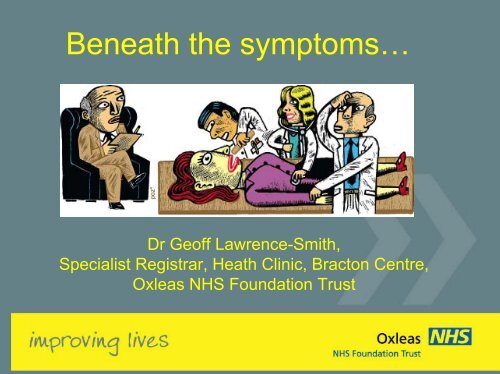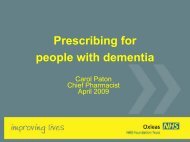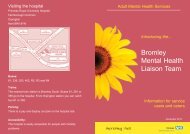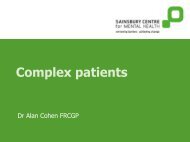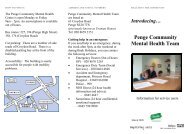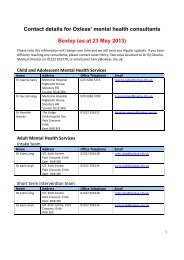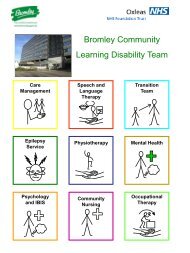Beneath the symptoms - Oxleas NHS Foundation Trust
Beneath the symptoms - Oxleas NHS Foundation Trust
Beneath the symptoms - Oxleas NHS Foundation Trust
Create successful ePaper yourself
Turn your PDF publications into a flip-book with our unique Google optimized e-Paper software.
<strong>Beneath</strong> <strong>the</strong> <strong>symptoms</strong>…Dr Geoff Lawrence-Smith,Specialist Registrar, Heath Clinic, Bracton Centre,<strong>Oxleas</strong> <strong>NHS</strong> <strong>Foundation</strong> <strong>Trust</strong>
AIMS• To understand what is meant by“Somatic Presentation of Distress”• To appreciate what research has to sayabout this illness• To be familiar with some techniques formanaging somatic presentations–To want to try <strong>the</strong>m out
Background• ‘Common-sense’ of ‘mind-body’ link– but dualism seems to persist• Stigma of ‘mental disorder/illness’• Easier to accept physical over emotional• Putting feelings/pain ‘into’ <strong>the</strong> body– unconscious
Examining Research Data• More than ¼ of primary carepatients in England haveMUS– 1/3 neurologicaloutpatients have<strong>symptoms</strong> inconsistentwith disease• Parental illness & lack ofcare in childhoodpredispose women to MUS(OR – 2.9)• Significant co-morbidity– Often psychiatric– Use of screening tools• PHQ – 9• HADS• HRQoL
Debate
Management• Regular scheduled appointments– With a physical examination– Signs over <strong>symptoms</strong>• Antidepressants• Psychological <strong>the</strong>rapies– CBT– Psychodynamic• Reattribution model• Future directions– Stepped care– Correspondence (Cochrane review)– Reclassification
Increasing Awareness inPrimary Care• Goldberg, Gask and Sartorius, 2001;“Training Physicians in Mental Health Skills”– Collaboration between Institute of Psychiatry,National Primary Care Research Centre and WorldPsychiatric Association– Seminars involving video and role-play todemonstrate and practice skills• The reattribution model– Recent skepticism (Morriss et al, 2007) but makespragmatic sense
4 - Stage Model• Understanding Symptoms• Broadening <strong>the</strong> Agenda• Making Links• Negotiating Treatment
Understanding Symptoms (1)• ‘Classical’ HPC– Onset– Duration– Previous experience– Improving/deteriorating– Aggravating/relieving factors– Associated features
Understanding Symptoms (2)• Typical Day• What do o<strong>the</strong>r’s think?– Introduction to allies• Health Beliefs– Experiences of illness in o<strong>the</strong>rs– Worries about future– Worries about diagnosis• How much worry, generally?– Scale 0-100%
Understanding Symptoms (3)• Physical examination– Good practice– Take patient seriously– Increase patient satisfaction
Broadening <strong>the</strong> Agenda• Acknowledge that pain is ‘real’• Subtle introduction of Psycho-socialaspects in a summaryReframe <strong>the</strong> Complaint
Collaborative problem listPredisposingPrecipitating(trigger)MaintainingBio -Psycho -(thinking)Social(relationships)DoctorMusculoskeletal chest painAbdominal cramp and bloatingMusculoskeletal chest painAbdominal cramp and bloatingMusculoskeletal chest painAbdominal cramp and bloatingMusculoskeletal chest painAbdominal cramp and bloating
Making Links (1)• Propose links between pain/symptomand stress/feeling low• ‘Tension’• Vicious CyclePAIN/SYMPTOMSSTRESS/LOWSTRESS/LOWPain• Reduced pain thresholdPAIN/SYMPTOMSLOWPAIN
Making links (2)• Linking to <strong>the</strong> ‘Here-and-Now’– “…stressful just talking about it!”• Experience of similar illness in o<strong>the</strong>rs– Easier to recognise emotional problems inour peers than ourselves
Making links (3)• Homework…for nextweekSymptomsWhenWhereWho withMood
• You can’t use <strong>the</strong>mall in one session– Pick your favourite• Use patient’s ownwords• Avoid diagnosticlabels unlessobviously helpfulDon’t Worry…
Treatment options• Negotiation between doctor and patient• Clarifying what happened during consultation– Acknowledge patient’s concerns• Patients know <strong>the</strong>ir lives best– Ways to “reduce pressure”• Returning to Health Beliefs– Ways to “manage worry”• Relaxation• Plan for FOLLOW - UP
That’s all very well…• Patients want you to own <strong>the</strong>ir<strong>symptoms</strong>• Using provocative and disturbinglanguage– Ring et al, 2004• Pts’ allies can help you• Peer group supervision– ? with a CBT <strong>the</strong>rapist
Cases from your experience
AIMS• To understand what is meant by“Somatic Presentation of Distress”• To appreciate what research has to sayabout this illness• To be familiar with some techniques formanaging somatic presentations–To want to try <strong>the</strong>m out
Thank you for listening
References• Do patients with unexplained physical <strong>symptoms</strong> pressurisegeneral practitioners for somatic treatment? A qualitative study.Adele Ring, Christopher Dowrick, Gerry Humphris, Peter Salmon, BMJ,doi:10.1136/bmj.38057.622639.EE (published 31 March 2004)• ABC of psychological medicine: Chronic multiple functionalsomatic <strong>symptoms</strong>. Bass & May, BMJ VOLUME 325 10 AUGUST2002• ABC of psychological medicine: Functional somatic <strong>symptoms</strong>and syndromes. Mayou & Farmer, 2002;325;265-268 BMJ– www.medicine.manchester.ac.uk/psychiatrytrainingvideos/• Very useful videos and DVDs with accompanying lecture notes• Why do people get ill? Leader & Corfield, 2007. ISBN 978 – 0 – 241– 14316 - 2


